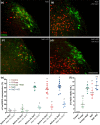Despite increasing aldosterone, elevated potassium is not necessary for activating aldosterone-sensitive HSD2 neurons or sodium appetite
- PMID: 33463885
- PMCID: PMC7814482
- DOI: 10.14814/phy2.14714
Despite increasing aldosterone, elevated potassium is not necessary for activating aldosterone-sensitive HSD2 neurons or sodium appetite
Abstract
Restricting dietary sodium promotes sodium appetite in rats. Prolonged sodium restriction increases plasma potassium (pK), and elevated pK is largely responsible for a concurrent increase in aldosterone, which helps promote sodium appetite. In addition to increasing aldosterone, we hypothesized that elevated potassium directly influences the brain to promote sodium appetite. To test this, we restricted dietary potassium in sodium-deprived rats. Potassium restriction reduced pK and blunted the increase in aldosterone caused by sodium deprivation, but did not prevent sodium appetite or the activation of aldosterone-sensitive HSD2 neurons. Conversely, supplementing potassium in sodium-deprived rats increased pK and aldosterone, but did not increase sodium appetite or the activation of HSD2 neurons relative to potassium restriction. Supplementing potassium without sodium deprivation did not significantly increase aldosterone and HSD2 neuronal activation and only modestly increased saline intake. Overall, restricting dietary sodium activated the HSD2 neurons and promoted sodium appetite across a wide range of pK and aldosterone, and saline consumption inactivated the HSD2 neurons despite persistent hyperaldosteronism. In conclusion, elevated potassium is important for increasing aldosterone, but it is neither necessary nor sufficient for activating HSD2 neurons and increasing sodium appetite.
Keywords: aldosterone; dietary sodium; mineralocorticoid; potassium; salt appetite; salt hunger.
© 2021 The Authors. Physiological Reports published by Wiley Periodicals LLC on behalf of The Physiological Society and the American Physiological Society.
Conflict of interest statement
None of the authors have any conflict of interest related to this work.
Figures





Similar articles
-
Aldosterone-induced salt appetite requires HSD2 neurons.JCI Insight. 2024 Dec 6;9(23):e175087. doi: 10.1172/jci.insight.175087. JCI Insight. 2024. PMID: 39446486 Free PMC article.
-
Control of sodium appetite by hindbrain aldosterone-sensitive neurons.Mol Cell Endocrinol. 2024 Oct 1;592:112323. doi: 10.1016/j.mce.2024.112323. Epub 2024 Jun 26. Mol Cell Endocrinol. 2024. PMID: 38936597 Review.
-
Aldosterone-sensitive HSD2 neurons in mice.Brain Struct Funct. 2019 Jan;224(1):387-417. doi: 10.1007/s00429-018-1778-y. Epub 2018 Oct 20. Brain Struct Funct. 2019. PMID: 30343334 Free PMC article.
-
Aldosterone-sensitive neurons in the nucleus of the solitary tract: bidirectional connections with the central nucleus of the amygdala.J Comp Neurol. 2006 Aug 1;497(4):646-57. doi: 10.1002/cne.21019. J Comp Neurol. 2006. PMID: 16739197 Free PMC article.
-
[Treatment for symptoms of pseudoaldosteronism].Nihon Naika Gakkai Zasshi. 2007 Apr 10;96(4):805-10. doi: 10.2169/naika.96.805. Nihon Naika Gakkai Zasshi. 2007. PMID: 17506322 Review. Japanese. No abstract available.
Cited by
-
Aldosterone-induced salt appetite requires HSD2 neurons.JCI Insight. 2024 Dec 6;9(23):e175087. doi: 10.1172/jci.insight.175087. JCI Insight. 2024. PMID: 39446486 Free PMC article.
-
Signal Transduction of Mineralocorticoid and Angiotensin II Receptors in the Central Control of Sodium Appetite: A Narrative Review.Int J Mol Sci. 2021 Oct 29;22(21):11735. doi: 10.3390/ijms222111735. Int J Mol Sci. 2021. PMID: 34769164 Free PMC article. Review.
-
Control of sodium appetite by hindbrain aldosterone-sensitive neurons.Mol Cell Endocrinol. 2024 Oct 1;592:112323. doi: 10.1016/j.mce.2024.112323. Epub 2024 Jun 26. Mol Cell Endocrinol. 2024. PMID: 38936597 Review.
References
-
- Adam, W. R. , & Dawborn, J. K. (1972). Effect of potassium depletion on mineral appetite in the rat. Journal of Comparative and Physiological Psychology, 78, 51–58. - PubMed
-
- Aguilera, G. , & Catt, K. J. (1986). Participation of voltage‐dependent calcium channels in the regulation of adrenal glomerulosa function by angiotensin II and potassium. Endocrinology, 118, 112–118. - PubMed
-
- Blake, W. D. , & Jurf, A. N. (1968). Increased voluntary Na intake in K deprived rats. Communications in Behavioral Biology Part A, 1, 107.
-
- Broadwell, R. D. , & Sofroniew, M. V. (1993). Serum proteins bypass the blood‐brain fluid barriers for extracellular entry to the central nervous system. Experimental Neurology, 120, 245–263. - PubMed
Publication types
MeSH terms
Substances
Grants and funding
LinkOut - more resources
Full Text Sources
Other Literature Sources
Medical

